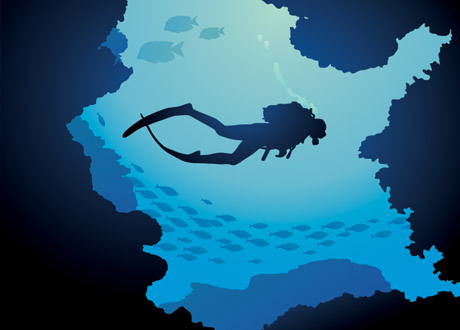By: Sheila Moorcroft
The blue economy, the term ascribed to a wide range of activities such as fishing, shipping, coastal tourism, energy, cable laying and mining, presents huge opportunities. Estimates of the current value vary from $6-$21trillion; a recent study put the value added arising from the EU opportunity alone at €500 billion, rising to €600 billion by 2020. Investment is growing, but also environmental concern. Deep sea mining is at present a small but increasingly significant element of that economy.
What is changing?
The oceans cover an area of about 360 million km2, at an average depth of about 3800 metres, and contain the world’s most active volcanoes, highest mountains and deepest valleys. At present, only about 5% of the ocean bed is accurately mapped, but the advent of new deep sea robotic submersibles as well as ever more sophisticated survey ships and even satellites is beginning to address the challenge. But it will be a long, slow process – the area that each ship or submersible can cover is small.
Deep sea mining is attracting significant investment. It was first attempted when the mineral-rich, deep sea vents surrounding underwater volcanoes were first discovered in the late 1970s: the cost and technical challenges of exploration prevented progress – till now. The sophistication of new technologies and the growing demand for and price of many mineral resources are changing the equations. Copper, zinc, manganese and gold – among many others – are all to be found in deep sea deposits, many of which are said to produce far higher levels of purity than their land based equivalents.
Global metal and mineral mining output was valued at $644 billion in 2010; but even land based mining is facing challenges as resource extraction moves to remoter and more inhospitable locations. Deep sea mining today provides almost none of that global supply, but by 2020 it could be providing 5%, 10% by 2030, valuing it at $65 billion in 2010 prices. However, to put the scale of deep sea deposits in perspective, the estimated value of deep sea gold deposits alone has been put at $150 trillion at today’s prices.
But it is very early days. To date, 12 exploratory permits have been issued and one area of active mining is underway off the coast of Papua New Guinea. However, controversy is not far away. The Papua New Guinea government is challenging the terms of the deal and environmentalists are challenging the adequacy of the environmental impact assessment. Exploration continues.
Why is this important?
The potential rewards are enormous. In coming years we may witness a new ‘gold rush’ as nations and companies try to establish technological leadership to capture as much of the market not just for the minerals, but for the technologies needed to locate and extract them. Aerospace and oil industry companies, electronics and robotics suppliers, marine and mining specialists all stand to gain as they transfer their various areas of expertise to this new frontier. Governments too are investing heavily including many emerging nation economies.
Depending on whether the scale of the deposits lives up to expectations and our ability to extract them proves technically and economically as well as environmentally viable, deep sea mining could change the mineral supply base. For example, deep sea mining may break the relative stranglehold China has on supplies of rare earths, essential for mobile phones and clean technologies. Demand for gold has been increasing – to offset fears of inflation and financial uncertainty, but also in consumer markets such as India; a significant increase in supply could destabilise price structures.
But the oceans are more than just a source of mineral wealth. They provide food for millions, raw materials for hundreds of products, influence our climate – and are relatively unknown. Whole new eco-systems and species are being found at these huge depths; many deposits are in international waters, raising issues of governance. A race to the bottom may enable us to extract the minerals, but it will also need to help us understand, protect and balance these other roles so that the benefits of the whole blue economy can be fulfilled.
By Sheila Moorcroft
About the author
 Sheila has over 20 years experience helping clients capitalise on change – identifying changes in their business environment, assessing the implications and responding effectively to them. As Research Director at Shaping Tomorrow she has completed many futures projects on topics as diverse as health care, telecommunications, innovation management, and premium products for clients in the public and private sectors. Sheila also writes a weekly Trend Alert to highlight changes that might affect a wide range of organisations. www.ShapingTomorrow.com
Sheila has over 20 years experience helping clients capitalise on change – identifying changes in their business environment, assessing the implications and responding effectively to them. As Research Director at Shaping Tomorrow she has completed many futures projects on topics as diverse as health care, telecommunications, innovation management, and premium products for clients in the public and private sectors. Sheila also writes a weekly Trend Alert to highlight changes that might affect a wide range of organisations. www.ShapingTomorrow.com
Photo: Diver from Shutterstock.com

